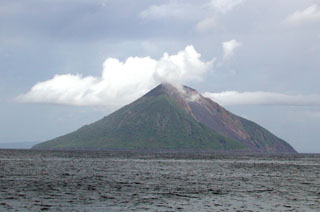Report on Tinakula (Solomon Islands) — June 1985
Scientific Event Alert Network Bulletin, vol. 10, no. 6 (June 1985)
Managing Editor: Lindsay McClelland.
Tinakula (Solomon Islands) Vapor and ash emissions
Please cite this report as:
Global Volcanism Program, 1985. Report on Tinakula (Solomon Islands) (McClelland, L., ed.). Scientific Event Alert Network Bulletin, 10:6. Smithsonian Institution. https://doi.org/10.5479/si.GVP.SEAN198506-256010
Tinakula
Solomon Islands
10.386°S, 165.804°E; summit elev. 796 m
All times are local (unless otherwise noted)
On 13 June at 0946 geologists (about 4 km from Tinakula in a boat) observed a vapor and ash cloud rising slowly from the crater. The ash emission was followed about 5 minutes later by whitish vapor, and the eruption cloud drifted slowly toward the W from the crater.
Stopping ~50 m from the breached NW side of the volcano, the geologists observed rising steam, and large boulders that rolled down the flank before splashing into the sea. There was no lava flow.
During the following two hours, no further eruption was observed as the summit was nearly always covered with clouds. A possible site for a telemetering seismometer was selected on the E side of the volcano at Mendana Cone. Local people reported that the volcano has exhibited similar low-level eruptive behavior since 1984.
Geological Summary. The small 3.5-km-wide island of Tinakula is the exposed summit of a massive stratovolcano at the NW end of the Santa Cruz islands. It has a breached summit crater that extends from the summit to below sea level. Landslides enlarged this scarp in 1965, creating an embayment on the NW coast. The Mendana cone is located on the SE side. The dominantly andesitic volcano has frequently been observed in eruption since the era of Spanish exploration began in 1595. In about 1840, an explosive eruption apparently produced pyroclastic flows that swept all sides of the island, killing its inhabitants. Recorded eruptions have frequently originated from a cone constructed within the large breached crater. These have left the upper flanks and the steep apron of lava flows and volcaniclastic debris within the breach unvegetated.
Information Contacts: D. Tuni, Ministry of Natural Resources, Honiara.

